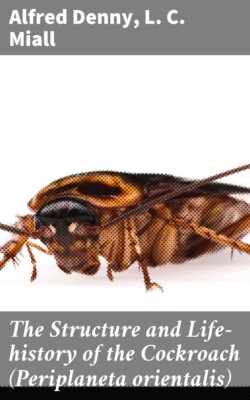Читать книгу The Structure and Life-history of the Cockroach (Periplaneta orientalis) - L. C. Miall - Страница 28
Parts of a Somite.
ОглавлениеAudouin’s laborious researches into the exoskeleton of Insects37 resulted in a nomenclature which has been generally adopted. He divides each somite (segment) into eight pieces, grouped in pairs—viz., terga (dorsal plates), sterna (ventral plates), epimera (adjacent to the terga), and episterna (adjacent to the sterna).
While admitting the usefulness of these terms, we must warn the reader not to suppose that this subdivision is either normal or primitive. The eight-parted segment exists in no single larval or adult Arthropod. Lower forms and younger stages take us further from such a type, instead of nearer to it; and Audouin’s theoretical conception is most fully realised in the thorax of an adult Insect with well-developed legs and wings.
The morphologist would derive all the varieties of Arthropod segments from the very simple and uniform chitinous cuticle found in Annelids and many Insect-larvæ. This becomes differentiated by unequal thickening and folding in, and a series of rings connected by flexible membranes is produced. Locomotive and respiratory activity commonly lead to the definition of terga and sterna, which are similarly attached to each other by flexible membranes. A pair of limbs may next be inserted between the terga and sterna, and the simple segment thus composed occurs so extensively in the less modified regions and in early stages that it may well be considered the typical Arthropod somite.
Special needs may lead to the division of the sterna into lateral halves, but this is purely an adaptive change. The third thoracic sternum of the male Cockroach, and the second and third of the female are thus divided, as is also the hinder part of the seventh abdominal sternum of the female.
In an early stage every somite has its tergal region divided into lateral halves, owing to the late completion of the body on this side. Traces of this division may survive even in the imago. There is often a conspicuous dorsal groove in the thoracic terga, and at the time of moult the terga split along an accurately median line (see fig. 12).
Additional pieces may be developed between the terga and sterna, and these have long been termed pleural.38 There may be, for example, single stigmatic plates, as in the abdomen of the Cockroach, pieces to support the thoracic legs, and pieces to support the wings; but the number and position of these plates depends upon their immediate use, and their homologies become very uncertain when Insects of different orders are compared. In general, the pleural elements of the segment are late in development, variable, and highly adaptive.
